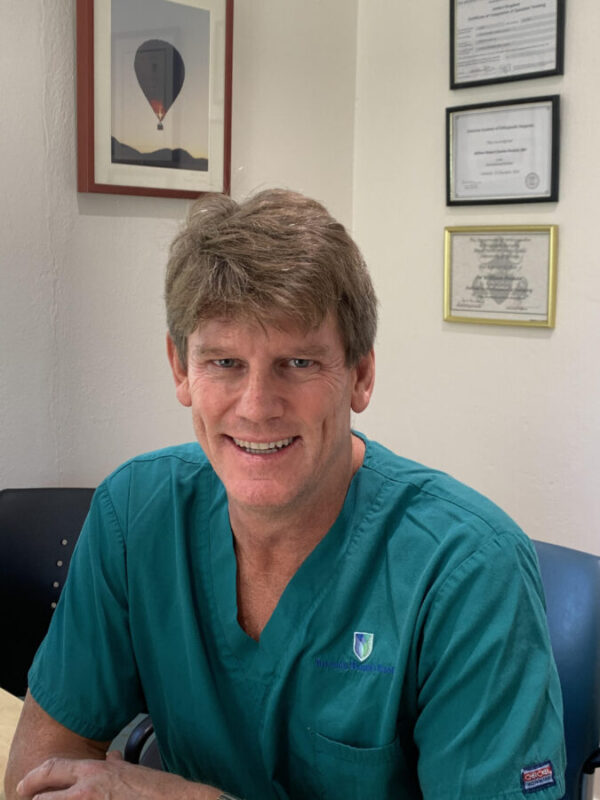Whether you were injured in a road accident, suffer from arthritis, or simply have age-related wear and tear, hip surgery is known for its excellent success rate. Yet, just because the pain that bugged you for years appears to have magically disappeared all at once, it doesn’t mean the job is done. As Dr Will Peckett says to his patients: “I can give you the Ferrari, but you have to build the engine.”
Physiotherapy is an essential component to ensuring good results from your hip operation.

“Without physiotherapy, patients will have a less good outcome in terms of your range of motion and exercise tolerance,” explained Dr Peckett, an orthopaedic surgeon at Orthopaedic & Physiotherapy Associates on Point Finger Road.
“People find it harder to go about their daily business or even walk around a shop. Top class athletes have high functioning bodies. Really, their function comes from hard work and training. If people want their bodies to function well after surgery, it’s really down them as patients.”
The most common reason for hip surgery is osteoarthritis, which typically affects seniors. Other contributory factors in Bermuda include injuries from motorcycle crashes and lower limb weaknesses caused by obesity. Surgery can involve a total hip replacement; resurfacing hip replacement, in which the socket is replaced; or half-hip replacement, which is commonly done with a fracture.
According to the Arthritis Foundation in the United States, about 90 percent of patients who had severe pain before a hip replacement say they have little to no pain five years later. What exactly is the physiotherapy that contributes to these good results?
“The whole hip surgery journey should start at the point when it’s decided you need hip surgery. Preparation should start at that point,” Dr Peckett said. “I speak to my patients, as do all surgeons. They have a pre-op physiotherapy appointment where we discuss how to move after a hip replacement. How to use apparatus such as a toilet riser or rail. They have a pre-op assessment at the clinic, with the anaesthetist at the hospital and pre-op nurses.
“They are given all sorts of information on what they need to do before and after surgery. This includes wound care, basic circulatory exercises and advice on how to manage their discharge from hospital. Once they have the surgery, they are in a space to start moving and get blood flowing to minimise the risk of problems.”
Some patients find pre-op therapy difficult because they are already in pain. They can reduce this impact by improving their fitness and losing weight through activities like swimming, cycling, aqua aerobics and seated strengthening exercises.
After surgery, patients learn to walk again with aids such as a frame or crutches. Working on your core strength will also help your hip to work better, while specific stretches help with the range of motion. The physiotherapist will give precautions to help with mobility and safety when moving around.
One patient who knows the value of rehabilitation is Kenneth Darrell.

Mr Darrell broke his tibia fibula in a road accident when he was about 30 and initially recovered. But, he said: “After that I was not walking freely. My left leg kicked out to the side a little bit. It wore my hip down because I wasn’t walking correctly. When I realised what was happening, I tried to correct it – but once I started walking correctly it was too late.”
He underwent hip resurfacing surgery in 2014, followed by six months of rehabilitation that included walking up steps, using a pedal bike and vigorous muscle training.
“Once the hip was done, it was like night and day,” recalled Mr Darrell, who is now 52. “I had been walking with a limp for a long period of time. Once I got over the surgery, I felt really good.”
He began to feel a throbbing pain again five years later, and it transpired there had been movement of the bone. This time he underwent a total hip replacement. “It went real good. I’m fine now. No pain, no issues,” he said. “The physio wasn’t as bad this time because I had been there already.”
Mr Darrell is a keen sportsman who was happy to embrace the physiotherapy, but what about those who find self-motivation more difficult?
Dr Peckett is confident most still manage to do enough: “Those who struggle with motivation are more common than the driven person who does the exercise every day,” he said. “We are all guilty of a lack of self-discipline at some point in our lives. I’m not saying physiotherapy is not important, but real-life people do get real-life good results despite the frailties of human nature.
“With a hip replacement, it’s a good operation, particularly with someone who has had hip pain for many years. The next day they will often say, ‘Oh gosh, my pain is gone!’”
Improvements in hip surgery over the past two decades means the amount of time patients spend in hospital has been dramatically reduced, which frees up beds, ensures people are less likely to get an infection or blood clots, and they can get back to work quicker.
“Nineteen years ago, my patients would stay in hospital five to seven days after a hip replacement,” Dr Peckett said. “Now my patients are more likely to go home at the end of surgery. Some don’t even stay in hospital overnight and are seen at home the next day by a physiotherapist.”
If you’re wondering how to keep your hips healthy in the first place, the advice is simple: low impact cyclical exercise, cycling and swimming.
“Joints are nourished by use,” Dr Peckett said.
Even so, the number of hip surgeries is expected to continue increasing in the coming decade as young people try to run faster and harder, while the population generally grows older and bigger.
“Andy Murray is playing world class tennis with a hip replacement,” he said. “That’s someone whose sport career was over. Extraordinary. It’s a great operation.”

